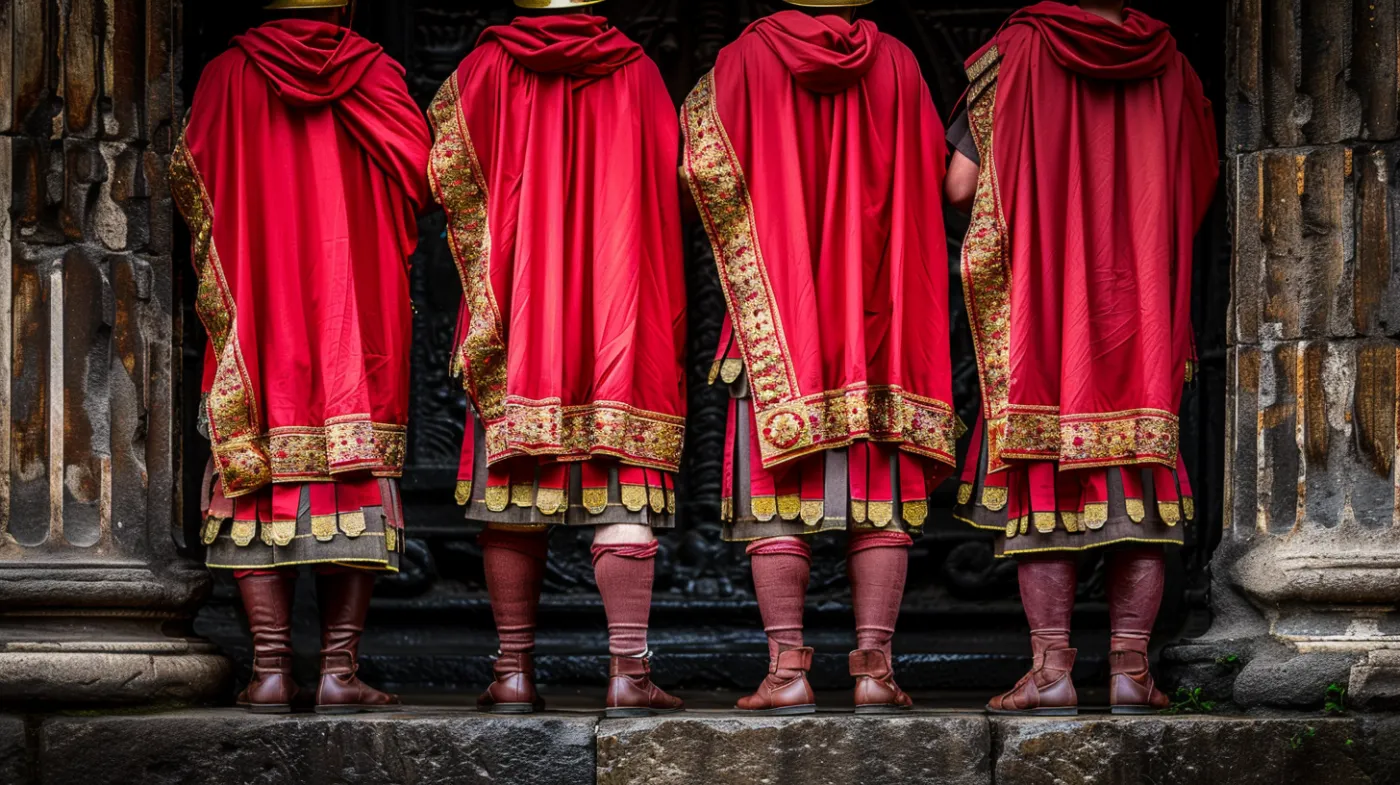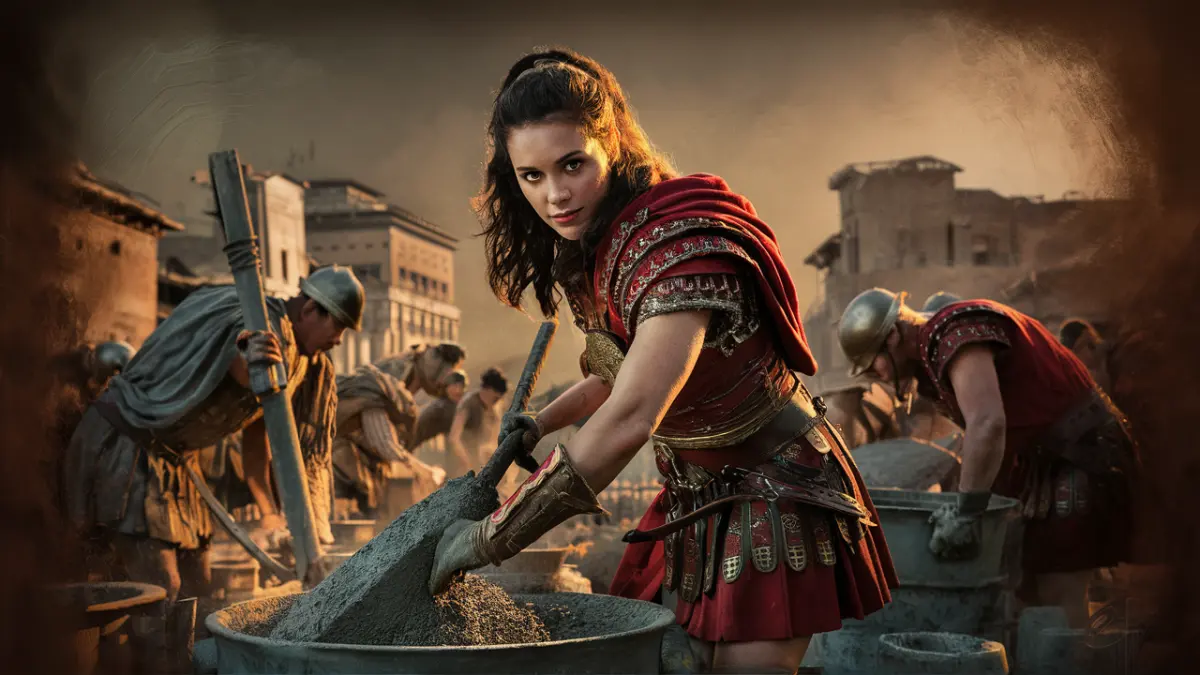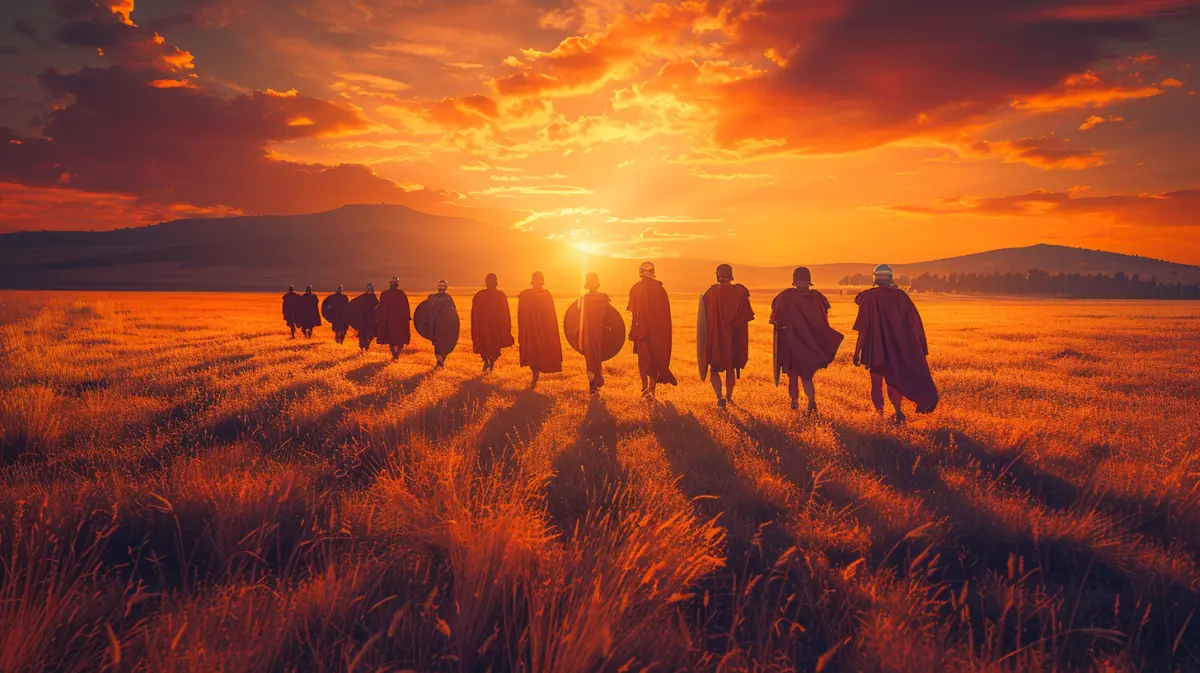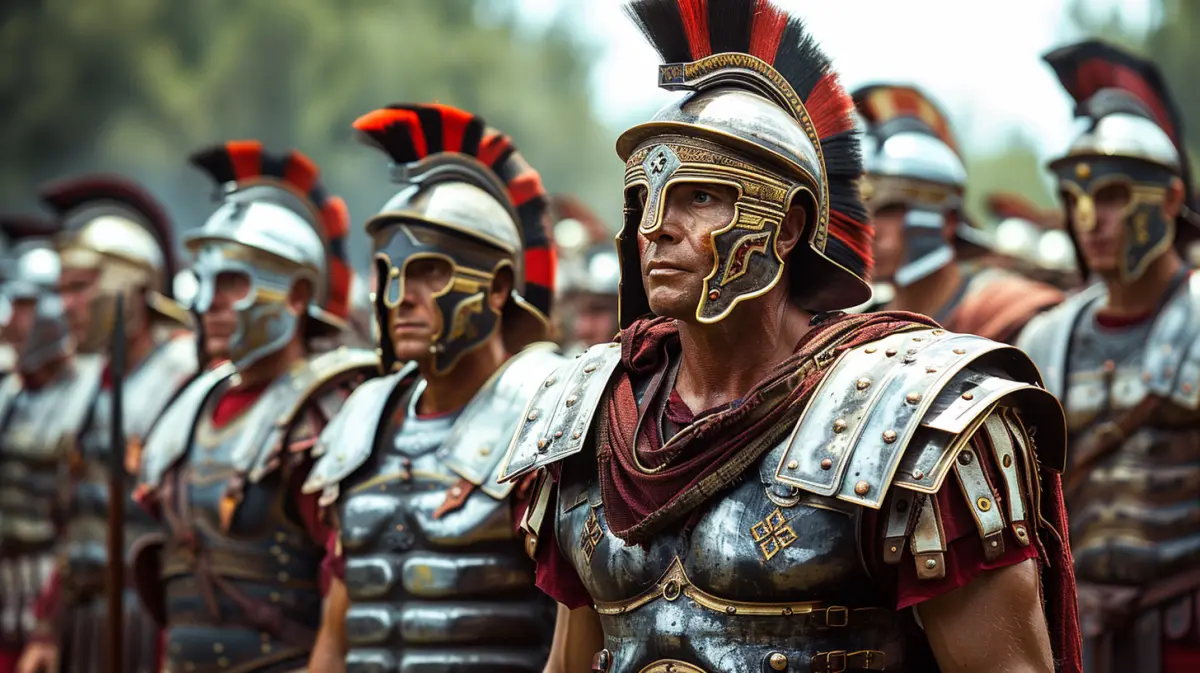10 Mind-Blowing Facts About the Romans You Didn't Know

The Romans were known for their impressive achievements and unique culture, which continue to fascinate people today. From their legendary founding to their vast empire, what makes the Romans so incredible?
If you think ancient Romans only wore togas and built big arenas, think again. They were pioneers in engineering, law, and even entertainment. Let's debunk some of the biggest myths:
- They didn't all wear togas
- Gladiator fights weren't daily events
- Rome wasn't built in a day
1. The Romans Invented Concrete
The Romans were ahead of their time, especially with their construction skills. They invented concrete, a material still used today. Roman concrete, also known as opus caementicium, was a game-changer.
They made it by mixing volcanic ash, lime, and water. This combo created a super-strong material. This concrete was used to build structures that have lasted thousands of years.
Biggest Misconceptions:
- Roman concrete is the same as modern concrete. Wrong! It's similar but had unique ingredients.
- Only used for buildings. Nope! It was also used for underwater structures, like harbors.
One of the most famous examples is the Pantheon in Rome. Its huge dome is a testament to the strength of Roman concrete. Another is Caesarea harbor, showcasing its versatility and durability underwater.
What’s cool is that the secret ingredient, volcanic ash, made it extra durable. This helped the concrete resist cracking and crumbling over time.
Roman engineers knew what they were doing, and their concrete still surprises scientists today. They even used it in seawalls, which have withstood centuries of ocean waves.
These incredible feats show just how advanced Roman engineering was. They left a lasting legacy, literally set in stone.

2. Had a holiday called 'Saturnalia'
Saturnalia was a week-long bash celebrated by the Romans. It honored Saturn, the god of agriculture. The fun kicked off on December 17th and wrapped up on December 23rd. Imagine if New Year's, Christmas, and Halloween had a wild party and you get the idea.
During Saturnalia, everything turned upside down. Slaves became masters for a day, and kids ruled the roost. It was role-reversal galore. People exchanged gifts and feasted like there was no tomorrow.
Here are some fun facts about Saturnalia:
- Role Reversals: Slaves and their masters would swap places.
- Gifts Galore: Everyone exchanged gifts, much like Christmas.
- Feasting and Merrymaking: Feasts, drinking, and playing games were common.
This festival brought the entire Roman society together. Public banquets were held and homes were decorated with greenery and lights, kinda like modern-day Christmas. The Romans would shout "Io Saturnalia!" which means "Hail Saturn!" This was truly a time of joy and fun in ancient Rome.
Saturnalia shows us that even the ancient Romans knew how to have a good time. This festival left a mark on later holiday traditions, including some we celebrate today. Who knew the Romans were such party animals?
3. Gladiators were considered celebrities
In ancient Rome, gladiators were the rock stars of their time. They weren't just fighters; they were legends in the arena. People would cheer their names and wear their colors.
Some gladiators were slaves, but many were volunteers. Marcus Attilus, for example, was a free-born Roman who decided to join the ranks. His choice made him stand out in a unique way.
Gladiators earned their fame through brutal battles. Some fights even ended in a draw, and both warriors were hailed as heroes. Priscus and Versus are famous for such a match, where both walked away victorious.
Crowds loved their favorite gladiators. Some gladiators enjoyed fan mail and gifts, similar to modern-day sports stars. They had fans who followed their careers closely.
Plenty of myths surround gladiators, including:
- They always fought to the death: False! Many fights ended with both gladiators alive.
- Only men were gladiators: Wrong again. Women also entered the arena, though less frequently.
Despite the danger, the allure of fame drew many to the arena. There's a reason gladiators remain such an enduring image of Roman culture.
4. Invented the Julian Calendar
The Romans were a clever bunch, and one of their smartest moves was creating the Julian Calendar. Before Julius Caesar came along, the Roman calendar was a mess. It was based on the lunar months and often fell out of sync with the seasons.
Julius Caesar, with help from the Alexandrian astronomer Sosigenes, decided to sort things out. They came up with a calendar that was based on the solar year. This new calendar had 365 days divided into 12 months. To keep things accurate, they added a leap year every four years with an extra day.
- The Julian Calendar was introduced in 45 BCE.
- It replaced the old Roman calendar to align with the solar year.
- A year had 365.25 days, accounting for leap years.
One funny thing they did was make the year 46 BCE last for 445 days! They needed to fix the calendar’s drift and get things back on track with the seasons. It must have been an exhausting year for those Romans!
The Julian Calendar was a big improvement and was used for over 1,600 years. Eventually, it was replaced by the Gregorian Calendar in 1582 because it was just a bit too long by about 11 minutes each year. Yet, its legacy lives on.
5. Built the first shopping mall (Trajan's Market)
Trajan's Market in Rome takes the crown for being the world’s first-ever shopping mall. Imagine the hustle and bustle of ancient Rome, where people shopped for goods just like we do in modern malls.
Built between 107 and 110 AD, Trajan’s Market was constructed by the famous architect Apollodorus of Damascus. He designed a large semi-circular complex filled with shops and small businesses.
The market had over 150 shops and offices! People could buy anything from food to clothes. It was like a one-stop shop for all their needs.
Trajan’s Market was not just about shopping. It also served as an administrative center and included a residential apartment block. It truly was ahead of its time.
Picture this: You’re in ancient Rome, walking through marble-floored hallways, surrounded by incredible architecture, and doing a bit of shopping. Quite a surreal experience!
Biggest Misconceptions:
- Not Just a Market: It included government offices and apartments.
- Built Quickly: It took several years to complete.
- Simple Design: It had an intricate, multi-level design with streets and terraces.
Trajan's Market remains a significant archaeological site, giving us a peek into the daily lives of Romans. A stroll through its ruins today is like flipping through the pages of a history book, one stone at a time.

6. Roman Armies Used Turtles (Testudo Formation)
You might think Roman soldiers hung out with actual turtles. Nope! They had a formation called "testudo," which is Latin for tortoise.
In this formation, soldiers created a shield wall. The ones in front and on the sides interlocked their shields. The guys in the back held shields over their heads. That way, they looked like one giant armored turtle.
Testudo was super effective against arrows and other flying weapons. It was mainly used to protect legionaries when approaching enemy fortifications.
Historians believe about 27 soldiers made up a typical testudo. This formation was also seen later in the Middle Ages, showing its staying power.
So, next time you think of Roman soldiers, imagine them as a squad of human turtles marching into battle!
7. Romans Used Urine for Teeth Whitening
The ancient Romans had some strange beauty secrets. One of the weirdest? They used urine to whiten their teeth. Yep, you read that right.
Romans believed that both human and animal urine would help keep their teeth bright and free of decay. They would use it as mouthwash and even mixed it with pumice to make a kind of toothpaste.
Why would they do this? When urine sits out, it turns into ammonia, which can whiten teeth. It sounds gross, but it actually works. The idea became so popular that even the Roman poet Catullus mentioned it.
Biggest Misconceptions
-
Gross and Unhealthy: Despite how it sounds, using urine for teeth whitening was effective thanks to ammonia.
-
Only Romans: Not just a Roman thing. Other ancient cultures also knew about urine’s cleaning powers.
It’s wild to think about, but this wasn’t the only way Romans used urine in daily life. It was a common cleaning agent used in many surprising ways.

8. Invented Bound Books (Codices)
The ancient Romans are the masterminds behind the first bound books, known as codices. Before this, folks were using long, unwieldy scrolls or heavy clay tablets for writing.
A codex is essentially a stack of pages bound together, much like the paperback books we have today. The earliest versions were made of wax tablets, but later they used materials like vellum or papyrus.
These bound books were not just a convenience; they were revolutionary. Codices were compact and easier to handle, making reading and transporting information a breeze.
Biggest Misconceptions
- Not just for elites: Many assume codices were for the upper class, but they were quite widespread.
- Purely practical: Codices were seen as tools, but they also had a certain charm and appeal.
- Only for Romans: While Romans popularized them, other cultures adopted the codex too.
Switching from scrolls to codices marked a big step in the way information was recorded and shared. It allowed for easier access to knowledge and contributed to the spread of literature and ideas.
The creation of the codex is just another example of Roman ingenuity, showing how their innovations laid the groundwork for many things we take for granted today.
9. Had Public Restrooms with Communal Sponges
Ancient Rome had public restrooms that weren’t like anything we see today. These public latrines were open-air and mostly used by the common folks. Multiple people could sit side-by-side, doing their business right next to each other. Privacy wasn't exactly a thing back then.
Instead of toilet paper, Romans used a tool called a xylospongium. Think of a stick with a sea sponge attached to the end. This communal sponge was shared by everyone in the restroom. Yikes, right?
To clean these sponges, they were rinsed in water and vinegar. Yet, this wasn’t the most sanitary system. The chance of spreading bacteria was pretty high. It wasn’t exactly a germ-free experience.
Some interesting tidbits:
- Public: Anybody could use these restrooms.
- Shared tools: One sponge, many users.
- Cleaning method: Rinsed in water and vinegar.
Despite the hygiene risk, these toilets were a big deal. They showcased Roman engineering skills and their commitment to urban infrastructure. These public latrines were connected to sophisticated sewer systems that kept cities relatively clean.
It's kind of wild to think about, but Roman restrooms were both innovative and, by modern standards, a bit gross.
10. Roman baths were social hubs
The Roman baths weren't just for getting squeaky clean. These places were the ancient version of a busy café. Imagine a lively space where friends meet, strangers chat, and business deals happen. Everyone, from peasants to senators, had a spot here.
Romans loved to relax and bond over heated conversations (literally). The baths had hot and cold rooms, swimming pools, and even libraries. It wasn't just about hygiene; it was about community. People came to unwind, exchange gossip, and make new friends.
Here are some facts to clear up misconceptions:
- Not Just for the Rich: Entry fees were low, so even the common folk enjoyed these luxuries.
- More Than Baths: These hubs had gymnasiums, gardens, and snack bars.
- Mixing Business and Pleasure: Many political and business meetings happened here.
So, next time you think of Roman baths, picture a bustling social scene rather than just a giant ancient bathtub. It was all about connecting, relaxing, and maybe even plotting your next big move.
Daily Life Of A Roman
Romans lived unique lives full of interesting routines and distinctive customs. They had their own ways of arranging living spaces and choosing what to wear every day.
Living Quarters
Most Romans lived in apartment buildings called insulae. These were crowded and often noisy. The poor lived on the upper floors, which were harder to reach and sometimes less safe. Wealthier Romans enjoyed lower floors with more space.
The rich lived in grand homes called domus. These houses had multiple rooms, gardens, and beautiful decorations. Often, they had a central courtyard called an atrium where families gathered.
Inside, rooms were simple but functional. Kitchens were small, as cooking was mostly done outside or by slaves. Bedrooms had basic furniture, usually a bed and a chest for personal items.
Clothing And Fashion
Romans were quite particular about their clothing. Men typically wore tunics, which were simple garments made of wool. For formal occasions, they wore togas, which were large, draped pieces of cloth that showed their status.
Women wore stolae, long dresses that reached their ankles. Over it, they might wear a palla, a shawl-like garment. Jewelry and accessories were popular, too. Wealthy women loved to show off their gold bracelets, earrings, and necklaces.
Footwear was also a part of their fashion statement. Sandals were common, but boots were worn during colder months.
Despite their simple materials and designs, Roman clothing carried a lot of meaning and displayed social status clearly.
Roman Food And Drink
Roman cuisine was diverse and varied across different social classes. Rich Romans enjoyed elaborate feasts while the poor relied on simpler, staple foods.
Common Dishes
Everyday Roman meals included bread, vegetables, and pulses. Bread was a staple for nearly everyone. The Romans also enjoyed various vegetables like asparagus, artichokes, and leeks. To keep things interesting, they often pickled these veggies in brine or vinegar.
For protein, they ate fish, pork, and poultry. Meat was often reserved for the wealthier classes. Pulses like lentils and peas were common, too. These ingredients provided the backbone of a Roman diet, made up of simple fare but packed with nutrition.
Banquets And Feasts
Banquets in Rome were a completely different ballgame. Picture a table overflowing with exotic dishes and elaborate recipes. These feasts were a show of wealth and class. Dishes could include peacock, dormice, and flamingo!
These grand events were not just about the food but also about the opportunity to impress guests. Spices and sauces played a big part in the flavor explosion. Romans would use garum (a kind of fish sauce), honey, and wine to kick their dishes up a notch.
While the poor stuck with hearty staples, the rich lived it up with every bite, showcasing their opulent lifestyle.
Roman Architecture And Engineering
The Romans were masters of building impressive structures like aqueducts and bridges. They used clever techniques to create things that last even today.
Aqueducts
Rome wouldn't have been the same without its aqueducts. These structures brought fresh water from distant sources into cities and towns. The Romans built these using a series of arches, which helped keep the water flowing smoothly over long distances.
Aqueducts weren't just functional; they were also beautiful. Some, like the Pont du Gard in France, are still around today. Roman aqueducts used gravity to move water, which was brilliant for the time. They even invented special materials like pozzolana, a volcanic ash that made their concrete stronger.
The water from aqueducts fed public baths, fountains, and homes. This helped keep cities clean and provided water for everyone, rich and poor alike.
Roads And Bridges
Roman roads and bridges were key to their empire's expansion. The saying "All roads lead to Rome" isn't just a figure of speech. Over 50,000 miles of roads connected the vast Roman Empire.
These roads were famous for their durability. Layers of sand, gravel, and stones made them solid. This design helped armies, traders, and messengers travel quickly and efficiently. Bridges were crucial for crossing rivers and ravines. The Romans built strong bridges using stone and concrete. The Alcántara Bridge in Spain is a great example, still standing after almost 2,000 years.
Roman roads and bridges weren’t just practical; they were an engineering marvel. They connected people, facilitated trade, and helped spread Roman culture far and wide.
They even had mile markers, kind of like ancient GPS, which made travel easier. The impact of Roman engineering is still felt today. Modern roads and bridges owe a lot to Roman ingenuity.
